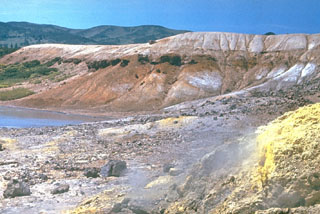Report on Tomariyama [Golovnin] (Japan - administered by Russia) — November 1988
Scientific Event Alert Network Bulletin, vol. 13, no. 11 (November 1988)
Managing Editor: Lindsay McClelland.
Tomariyama [Golovnin] (Japan - administered by Russia) Fumarolic activity
Please cite this report as:
Global Volcanism Program, 1988. Report on Tomariyama [Golovnin] (Japan - administered by Russia) (McClelland, L., ed.). Scientific Event Alert Network Bulletin, 13:11. Smithsonian Institution. https://doi.org/10.5479/si.GVP.SEAN198811-290010
Tomariyama [Golovnin]
Japan - administered by Russia
43.844°N, 145.504°E; summit elev. 535 m
All times are local (unless otherwise noted)
Fumarolic activity, concentrated at the foot of the lava dome, continued at a constant level. The temperature of the hot lake in the same area had not changed, but varied within the lake from 34 to 84°C. The temperature of the stream that flowed from the lake remained at 30-34°.
Geological Summary. Tomariyama, also known as Golovnin, forms the southern end of Kunashir Island, across the Nemuro Strait from Hokkaido. Explosive activity has dominated in the formation of this andesitic-dacitic volcano; no lava flows are exposed. The gently sloping stratovolcano is truncated by a 4-5 km caldera that formed during a series of late-Pleistocene eruptions beginning about 43,000 years ago. Several lava domes were subsequently emplaced on the caldera floor. Topographic highs outside the caldera rim are lava domes extruded along a ring structure or an outer caldera. A 1 x 2.5 km caldera lake on the northern side of the inner caldera drains through a narrow breach in the western caldera wall. Solfataric activity occurs at the northern lake shore and at explosion craters (one of which contains a hot crater lake with reported temperatures from 36-100°C) that cut the caldera-floor lava domes. The only known recorded eruption was a minor explosion in 1848.
Information Contacts: G. Steinberg, Yuzhno-Sakhalinsk.

